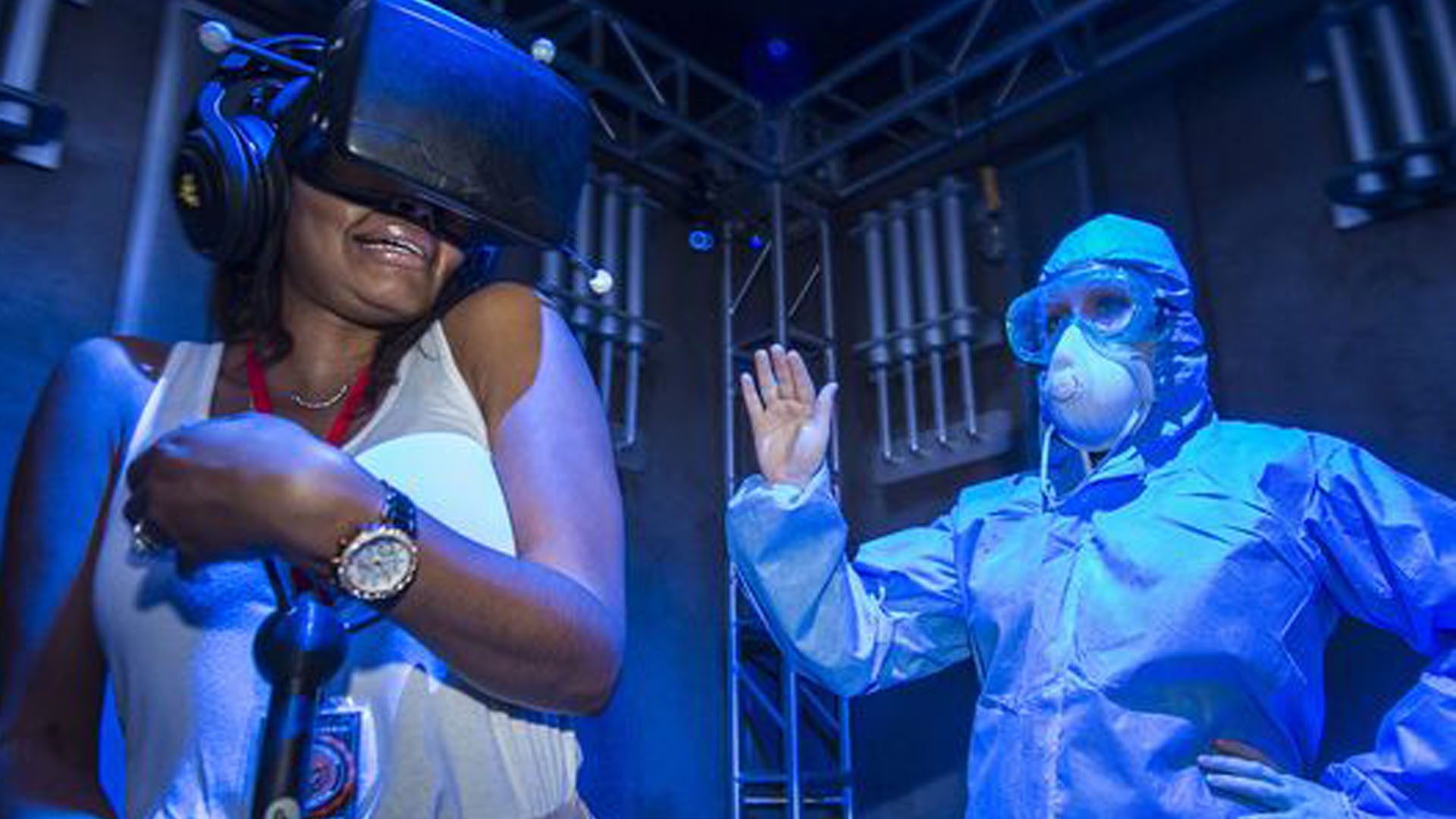"Your assignment is simple. Find the key!" barked the official in the orientation video. As it turned out, it wasn't so simple.
My fellow recruits and I were preparing to enter The Repository, an add-on virtual reality experience that Universal Studios Florida is offering as part of Halloween Horror Nights through October 31. Borrowing the concepts of interactive theater, haunted houses, collaborative escape rooms, and featuring VR technology, the small-group experience costs $49.99. Reservations are required, and participants must also purchase tickets to Universal's Halloween event.
After signing a release in which, among other things, we agreed not to bring any claims against Universal for personal injury or mental distress (which made me wonder was about to happen), my group of four made its way to The Repository to begin our journey. For those who might be thinking about trying the experience, I suppose I should warn you about the spoilers that will follow. Honestly, however, I'm not sure I could share salient details even if I wanted to.
I was fully prepared, eager even, to find "the key." I was especially excited about donning a VR headset and seeing how Universal would incorporate the emerging technology into the attraction. After making my way through the 30-minute experience, I can say I did not suffer any mental distress. But I left confused and wondering what just happened.
Don't get me wrong. The Repository included some wonderful things. The physical sets were lavishly detailed, and the live actors that interacted with us were great. The first room was crammed with vintage artifacts. Under the watchful eye of a military officer, an eccentric curator encouraged us to examine the props. Other scenes included a dingy room presided over by a key-obsessed lunatic and a research lab headed by a sadistic scientist.
Compared to the conga-line, wham-bam-scare-you-ma'am dash through Halloween Horror Nights' regular haunted mazes, the intimate size of our group and the leisurely pace at which we made our way through the space allowed us ample time to explore the details and enjoy lively repartee with the "scareactors." To further differentiate The Repository from HHN, the actors did physically touch us. Their gentle manhandling never threatened to cause personal injury, but it did give the proceedings a nice edge.
But the centerpiece VR experience seemed not quite ready for prime time yet. I later learned that we were supposed to be gathering clues to solve a mystery. It involved decoding symbols and arranging colors in a specific order. In doing so, our team would fashion the key to end a centuries-old curse and dispel the supernatural evil that had haunted the bizarre warehouse. With little direction and no clear continuity, the storyline was lost on me.
It should be noted that I made my way through The Repository during technical rehearsals on the day before it opened to the general public, and it was a work in progress. "We're fine tuning it," said TJ Mannarino, senior director of art and design at Universal Orlando and a Halloween Horror Nights vet. The theme park company has been exploring VR for about two years, and The Repository marks its first attraction to use the technology. "It's a great experiment for us," Mannarino added. "It's a good way to see how people work within this strange social environment."
It may be Universal's first attempt at VR, but the wizards who design the parks' attractions are masters at conjuring alternate realities. Using large-format media, roving motion-base ride vehicles, advanced robotics, and other whiz-bang technology, they have developed groundbreaking attractions that send visitors flying with Harry Potter, freefalling off skyscrapers while helping Spider-Man fight crime, and other adventures. During the Halloween season, Universal's haunted houses unleash otherworldly creatures to terrorize guests amid stunning, immersive environments.
By using VR, the terrormeisters reverse the dynamic and transport guests to the paranormal world. At least, that was the intent. For the ten minutes or so that I wore VR goggles, the physical room faded away and was replaced by a virtual library. It later morphed into a graveyard.
The novelty of the VR experience was initially captivating. The graphics had the look and feel of a decent videogame, but didn't have the you-are-there credibility of a fully realized environment. Universal amped up the visuals with sensory enhancements including subwoofer rumbles, heat and wind blasts, and digitally tracked live actors who imposed themselves as spectral ghosts in the virtual landscape.
I could hear a dispatcher from the "Legendary Truth" command post giving me directions and asking me questions about my mission in the supernatural world, but the spiel was prerecorded and no actual interaction was possible. I was paired with one other member of my team, and we could see each other represented as masked avatars. But we could not communicate with each other, nor, as far as I know, could we work together. I didn’t understand what, if anything, I was supposed to do other than look around and try to take it all in.
An assistant in a hazmat suit abruptly ended the VR visit to the supernatural world, and an officer hustled my partner and me to the final puzzle room where we were reunited with the two other members of our team. Nobody had cracked the code, and we randomly tried to solve the puzzle to no avail before time ran out. During a post-mission debriefing with my team members, I discovered that The Repository also baffled them.
"A lot of people fail," acknowledged Tom Geraghty, advanced technology director at Universal Creative and one of the attraction's architects. "We may have to put in more hints." The designer said that he and his team were trying to find the balance between providing enough information and handholding so that participants could succeed and giving them enough latitude to discover things on their own.
Mannarino added that the experience was built on interaction. "It's all about [the participants] and what they do together with the actors, objects, and each other. You're the show. We respond to what you do."
What our team did, or more accurately, what we didn't do, may have failed to end the evil curse. Our simulated journey to the paranormal world did not adequately prepare us for our real-world mission. Nonetheless, I look forward to future applications of virtual reality, augmented reality, and mixed reality in parks.
"We think VR is a huge part of the future of themed entertainment," says Geraghty. I agree. And I'm willing to bet that the folks at Universal who send people flying above Hogwarts Castle with aplomb will be able to crack the code.


